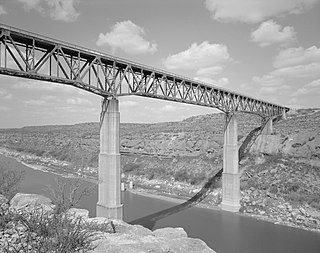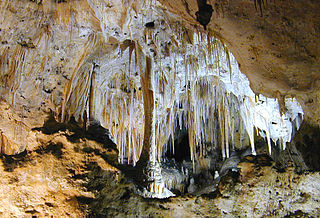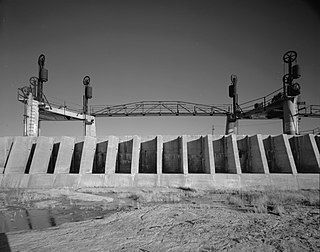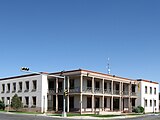
Roswell is a city in and the seat of Chaves County, New Mexico, United States. The population was 48,422 at the 2020 census, making it the fifth-most populous city in New Mexico. It is home of the New Mexico Military Institute (NMMI), founded in 1891. The city is also the location of an Eastern New Mexico University campus. Bitter Lake National Wildlife Refuge is located a few miles northeast of the city on the Pecos River. Bottomless Lakes State Park is located 12 miles (19 km) east of Roswell on US 380. Chaves County forms the entirety of the Roswell micropolitan area.

Eddy County is a county located in the U.S. state of New Mexico. As of the 2020 census, the population was 62,314. Its county seat and largest city is Carlsbad. The county was created in 1891 and later organized in 1892. It is north of the Texas state line.

Scouting in New Mexico has had a rich and colorful history, from the 1910s to the present day, serving thousands of youth in programs that suit the environment in which they live. The state is home to the Philmont Scout Ranch.

Artesia is a city in Eddy County, New Mexico, centered at the intersection of U.S. routes 82 and 285; the two highways serve as the city's Main Street and First Street, respectively. As of the 2020 census, the city population was 12,875.

La Huerta, formerly known as Carlsbad North, is an unincorporated area and census-designated place (CDP) in Eddy County, New Mexico, United States. The population was 1,246 at the 2010 census. The community, whose name means "fruit garden" in Spanish, was named after the orchards and garden plots that supplied food to Carlsbad.

Loving is a village in Eddy County, New Mexico. As of the 2010 census, the village population was 1,413. Loving was settled by Swiss immigrants in the 1890s.

The Pecos River originates in north-central New Mexico and flows into Texas, emptying into the Rio Grande. Its headwaters are on the eastern slope of the Sangre de Cristo mountain range in Mora County north of Pecos, New Mexico, at an elevation of over 12,000 feet (3,700 m). The river flows for 926 miles (1,490 km) before reaching the Rio Grande near Del Rio. Its drainage basin encompasses about 44,300 square miles (115,000 km2).

The United States Potash Railroad was a 3 ft narrow gauge railroad built in 1931 to carry potash from the mines to the mill at Loving, New Mexico where the Atchison, Topeka & Santa Fe Railroad had a spur that went out to the refinery to carry out the processed potash. The 16-mile (26 km) railroad was located at Loving, New Mexico, just east of Carlsbad, New Mexico, USA, and Carlsbad Caverns National Park.

Carlsbad Caverns National Park is a national park of the United States in the Guadalupe Mountains of southeastern New Mexico. The primary attraction of the park is the show cave Carlsbad Cavern. Visitors to the cave can hike in on their own via the natural entrance or take an elevator from the visitor center.
New Mexico State Road 7 (NM 7) is a 7.199-mile-long (11.586 km) paved, two-lane state highway in Eddy County in the U.S. state of New Mexico. NM 7 east terminus is in Whites City at the road's junction with U.S. Route 62 and U.S. Route 180 which run concurrently at that location. The road travels mostly west from there in a somewhat winding path leading to Carlsbad Caverns National Park Visitors Center.

With a total area of 121,590 square miles (314,900 km2), New Mexico is the fifth-largest state, after Alaska, Texas, California, and Montana. Its eastern border lies along 103°W longitude with the state of Oklahoma, and 2.2 miles west of 103°W longitude with Texas. On the southern border, Texas makes up the eastern two-thirds, while the Mexican states of Chihuahua and Sonora make up the western third, with Chihuahua making up about 90% of that. The western border with Arizona runs along the 109° 03'W longitude. The southwestern corner of the state is known as the Bootheel. The 37°N parallel forms the northern boundary with Colorado. The states of New Mexico, Colorado, Arizona, and Utah come together at the Four Corners in New Mexico's northwestern corner. Its surface water area is about 292 square miles (760 km2).

The Carlsbad Irrigation District, also known as Carlsbad Reclamation Project or Irrigation system of the Pecos Irrigation and Improvement Company, is a major early water reclamation project located near Carlsbad in southeastern New Mexico. Begun in the 1880s, it is now managed by the United States Bureau of Reclamation, and provides irrigation water to a large area around Carlsbad, diverted from the Pecos River and the Black River. The late 19th and early 20th-century elements of the project were designated a National Historic Landmark District in 1964.
The Southwestern Railroad is an American Class III railroad operating since 1990, and until 2017 consisted of two unconnected railroad sections in New Mexico, with no shared functions. These and a third section in the Texas panhandle and Oklahoma, now closed, all operated separately. Since January 2017, only the Whitewater Division is operated by Southwestern.

Brantley Dam is a flood-control and irrigation water-storage dam on the Pecos River in Eddy County, New Mexico, about 13 miles (21 km) north of Carlsbad, New Mexico, and 10 miles (16 km) upstream from Avalon Dam.

Avalon Dam is a small dam on the Pecos River about 5 miles (8.0 km) north of Carlsbad, New Mexico, United States. The dam is a storage and regulating reservoir, and diverts water into the main canal of the Carlsbad Project, an irrigation scheme.
Carlsbad Municipal School District, also known as Carlsbad Municipal Schools, is a school district in Carlsbad, New Mexico, United States.
Malaga is a census-designated place and unincorporated community in Eddy County, New Mexico, United States. Its population was 147 as of the 2010 census. Malaga has a post office with ZIP code 88263. U.S. Route 285 passes through the community. Formerly known as Kirkwell, Malaga was founded in the 1890s by Swiss immigrants and was named after the Spanish city of Málaga. Italian laborers were recruited to farm the area, and many settled in Malaga.

Whites City also spelled White's City, is a census-designated place and unincorporated community in Eddy County, New Mexico, United States. Whites City has a post office with ZIP code 88268.
Happy Valley is an unincorporated community and census-designated place in Eddy County, New Mexico, United States. Its population was 519 as of the 2010 census. The community is located on the western edge of Carlsbad; New Mexico State Road 524 passes through the area. The town was settled as a farming community before potash was manufactured here. It was named because the lack of land use regulations made residents happy.
Livingston Wheeler is an unincorporated community and census-designated place in Eddy County, New Mexico, United States. Its population was 609 as of the 2010 census. The community is located on the southeastern edge of Carlsbad along New Mexico State Road 216.


























